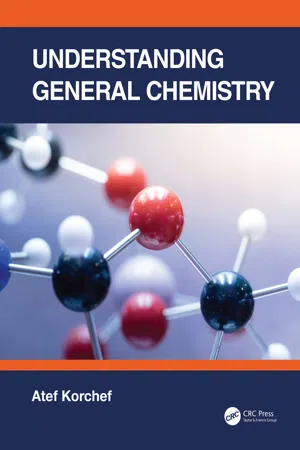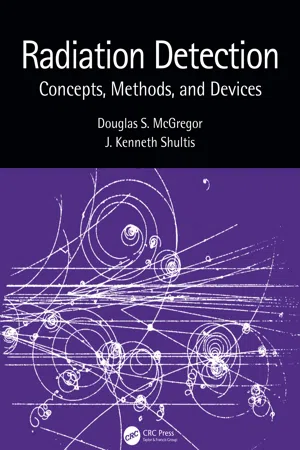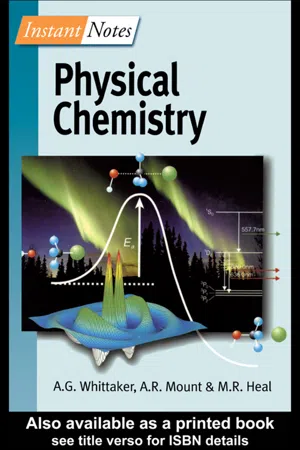Chemistry
Avogadro's Number and the Mole
Avogadro's number is a fundamental constant representing the number of constituent particles (usually atoms or molecules) in one mole of a substance. The mole is a unit used in chemistry to express amounts of a chemical substance. It allows for easy conversion between the mass of a substance and the number of atoms or molecules it contains.
Written by Perlego with AI-assistance
7 Key excerpts on "Avogadro's Number and the Mole"
Learn about this page
Index pages curate the most relevant extracts from our library of academic textbooks. They’ve been created using an in-house natural language model (NLM), each adding context and meaning to key research topics.
- eBook - ePub
- Alan J. Cann(Author)
- 2013(Publication Date)
- Wiley(Publisher)
4
Molarities and Dilutions
LEARNING OBJECTIVES:On completing this chapter, you should be able to:- understand the concepts of molarity and concentrations;
- be able to calculate the molarity of solutions;
- be able to calculate dilutions of solutions and suspensions.
4.1. Avogadro’s number
In the last chapter, we learned that the mole (from ‘molecule’) is the SI unit used to measure the amount of a substance (abbreviation = ‘mol’). Technically, one mole is ‘the amount of a substance which contains as many elementary entities as there are atoms in 0.012 kg of carbon-12’. This is a complicated definition, but in 1811 Amedeo Avogadro was the first person to clearly make the distinction between molecules and atoms. Avogadro suggested that equal volumes of all gases at the same temperature and pressure contain the same number of molecules, which is now known as Avogadro’s Principle. However, it was not until long after Avogadro’s death that the idea of the mole was introduced. The molecular weight in grams (1 mol) of any substance contains the same number of molecules. The number of molecules in 1 mol is now called Avogadro’s number. Avogadro had no knowledge of moles, or of the number that was to bear his name, since this was never determined by Avogadro himself.Avogadro’s number is: How big is Avogadro’s number?1. An Avogadro’s number of soft drink cans would cover the entire surface of the earth to a depth of over 200 miles. 2. If we were able to count atoms at the rate of 10 million per second, it would take about 2 billion years to count the atoms in 1 mol. 3. An Avogadro’s number of carbon-12 atoms (1 mol) weighs 12 g. An Avogadro’s number of moles of carbon-12 weighs the same as the Earth.4.2. Molecular weight
To have to consider the masses of individual molecules measured in grams would be very inconvenient, since this would involve extremely small numbers. Unfortunately, the only clearly defined unit in this area is the SI standard, the mole, and the derived unit of concentration, molarity. Molecular weight is the mass of 1 mol of a substance (in grams per mole). However, the term ‘molecular mass’ is used by some people to mean molecular weight (i.e. grams per mole) and by others to mean mass of a single molecule (in daltons, Da – the mass of a molecule relative to onetwelfth the mass of carbon-12 atom). Although numerically equal, molecular weight/mass (in grams per mole) and mass-of-a-molecule type molecular mass (in daltons) have different units. These problems are avoided by using ‘molecular mass’ only for the mass of individual molecules (in daltons) and ‘molecular weight’ or ‘molar mass’ for the mass of a mole of molecules (grams per mole). Relative molecular mass (M r ) is an attempt to avoid these problems by defining the apparent molecular weight of proteins etc. with reference to a set of standards. However, if M r is defined as molecular mass relative to one-twelfth the mass of carbon-12 atom (= daltons), then M r is really in daltons – a measurement which refers to individual molecules, not moles. M r is thus an illusion since it has no properly defined units, e.g. ‘M r - eBook - ePub
- Atef Korchef(Author)
- 2022(Publication Date)
- CRC Press(Publisher)
One mole (1 mol) contains 6.022 × 1023 entities (atoms, molecules, ions).The atomic mass (the mass of one atom) is the average mass of all the isotopes of an atom with respect to their abundances. The atomic masses of all elements are given in the periodic table of elements. The atomic mass is commonly expressed in atomic mass units (amu).1 a m u =g = 1.660 ×1 /N Ag10− 24- Example: A calcium (Ca) atom has a mass of 40 amu. The mass of calcium atom in g is (40/NA ) g = 6.642 × 10−23 g
The molecular mass is the sum ofthe atomic masses of all the atoms in the molecule. It is commonly expressed in atomic mass units (amu).- Example: One molecule of sulfuric acid (H2 SO4 ) contains two atoms of H, one atom of S and four atoms of O. The molecular mass M of sulfuric acid is
M = 2 ×+ 1 ×atomic mass of H+ 4 ×atomic mass of Satomic mass of O=+2 × 1+1 × 32= 98 amu4 × 16The mass of one sulfuric acid molecule in g is (98/NA )g = 1.627 × 10−22 gFor monatomic elements, the molar mass (mass of one mole, abbreviated as M or Mwt ) is the numerical value on the periodic table expressed in g mol−1 .- Example: The atomic mass of O is equal to 16 amu and the molar mass of O is equal to 16 gmol−1 .
For molecules, the molar mass is the sum of the molar masses of each of the atoms in the molecular formula.- Example: A molecule of H2 O contains two H atoms and one O atom. The atomic mass of O is 16 amu and the atomic mass of H is 1 amu. The molecular mass of H2 O is equal to 16 + 2 × 1 = 18 amu and the molar mass of H2 O is equal to 18 gmol−1
- eBook - ePub
- Colin Salter(Author)
- 2021(Publication Date)
- Pavilion(Publisher)
Avogadro’s Law greatly contributed to the understanding of gases. By the end of the century it led to the formulation of the kinetic theory of ideal gases, which explains the relationship between volume, pressure and temperature of gases and, among other things, Brownian Motion. In combination with the work of later scientists, including Michael Faraday, it led to the Avogadro constant, named in his honour, which is the total number of particles that make up a measure known as a mole. Moles may differ in mass and volume, but they all contain the same number of particles, be they ions, electrons, atoms or molecules. The number, the Avogadro constant, is 6.02214076×1023.Avogadro achieved a rare feat by getting his law of gasses printed on an Italian postage stamp in 1956.Amedeo Avogadro was born in Turin and spent his life there, teaching and researching at the University of Turin. - eBook - ePub
Radiation Detection
Concepts, Methods, and Devices
- Douglas McGregor, J. Kenneth Shultis(Authors)
- 2020(Publication Date)
- CRC Press(Publisher)
Appendix A Fundamental Physical Data and Conversion Factors A.1 Fundamental Physical Constants Although there are many physical constants, which determine the nature of our universe, the following values are of particular importance when dealing with atomic and nuclear phenomena. In 2017 the International Bureau of Weights and Measures defined the Avogadro constant N a to be exactly the very large integer 6.02214076 × 10 23 entities per mol. This change redefined the mol as the amount of a substance containing N a entities (atoms, molecules, etc.). As a consequence, the molar mass constant M u is no longer 1 g/mol but now is 0.999 999 999 65(30) × 10 −3 kg mol −1. It also means that 1 mol of 12 C atoms no longer has a mass of 0.001 kg. However, the atomic mass unit remains unchanged as 1/12 the mass of a 12 C atom. On the 144th anniversary of the Metre Convention, 20 May 2019, the redefinition of SI base unit was affirmed and came into force. In the redefinition, four of the seven SI base units—the kilogram, ampere, kelvin, and mole—were redefined by setting exact numerical values for the Planck constant h, the elementary electric charge e (q e as used in this book), the Boltzmann constant k, and the Avogadro constant N a, respectively. A.2 The Periodic Table The periodic table presented in Table A.2 uses the new group format numbers from 1 to 18 approved by the International Union of Pure and Applied Chemistry (IUPAC), while the numbering system used by the Chemical Abstract Service is given in parentheses at the top of each column. In the left of each elemental square, the number of electrons in each of the various electron shells are given. In the upper right of each square, the melting point (MP), boiling point (BP), and critical point (CP) temperatures are given in degrees Celsius. Sublimation and critical temperatures are indicated by s and t - eBook - ePub
- Kevin R. Reel(Author)
- 2013(Publication Date)
- Research & Education Association(Publisher)
23 (Avogadro’s number) particles in a mole. This value can be used to determine the number of particles in a mole of atoms or molecules.Example: How many atoms are in 0.2 moles of atoms? Solution:MASS
• Atomic and molecular weights can be used to convert moles to grams, and vice versa. Example: What is the mass of 4.20 moles of carbon atoms? Solution:GASES
• While stoichiometry problems can result in answers in moles, the ideal gas law can be used to convert that number of moles to some unknown variable in the ideal gas law equation. • At STP (standard temperature and pressure), 1.0 mole of gas occupies 22.4 liters. This can be used as a conversion factor in solving stoichiometric equations. Example: What is the volume of 8.26 moles of gas at STP? Solution:SOLUTIONS
• Stoichiometric problems that involve solutions usually require a molar solution conversion at some point to get the answer, where Example: How many moles of glucose exist in 1.4 liters of a 0.20-molar solution of glucose? Solution:STOICHIOMETRY PROBLEMS
• Stoichiometry problems refer to a type of question in which the student is given an amount of reactant or product in a chemical reaction, and then asked to find the corresponding amount of reactant or product.• Stoichiometry problems can all be solved using the following steps: 1. Balance the reaction. 2. Write down the units of the answer next to an equals sign “=”. 3. On the other side of an equals sign, write down the number and units of the given information. 4. Use a ratio to convert the given information into moles. 5. For the next ratio, use the balanced reaction to relate the number of moles of the given substance to the number of moles of the substance in the answer.6. Convert the number of moles of the substance in the answer to the actual units of the answer. Be sure that your answer has the correct units, and the same units as those that remain on the other side of the equals sign after the other units are canceled. - eBook - ePub
Chemistry
Concepts and Problems, A Self-Teaching Guide
- Richard Post, Chad Snyder, Clifford C. Houk(Authors)
- 2020(Publication Date)
- Jossey-Bass(Publisher)
−22 grams.In the past, problems involving chemical reactions have been called mass–mass, mass–volume, or volume–volume problems and have been solved using algebraic ratios or proportions. We feel the solution of these problems using the mole concept is superior and fosters a better understanding of what goes on in a reaction than ratio/proportion solving.The problem solving presented here uses solely the mole concept when we are dealing with chemical reactions. A chemist, chemical engineer, or metallurgist uses this technique to answer very important questions, such as how much raw material will be required to produce a specified quantity of product. Management then uses the cost of those materials and labor, along with other production costs, to determine the price of the product.OBJECTIVES
After completing this chapter you will be able to calculate the weight or number of moles of any reactant or product that will be used up (if a reactant) or produced (if a product) given a completely balanced chemical equation, a table of atomic weights, and a specified quantity (weight or moles) of any one reactant or product.Remember, a mole is6.022 × 1023(Avogadro's number) particles such as atoms, ions, or molecules. The weight of this number of particles is expressed in grams. A mole of hydrogen ions(H+ )contains how many hydrogen ions? _______ How much do they weigh? ________ (Calculate answers in this chapter to the nearest hundredth unless otherwise indicated.)Answer:6.022 × 1023; 1.01 gramsUnless otherwise stated, the term mole means the same as the term gram-mole. A gram-mole is the weight of6.022 × 1023 - eBook - ePub
- Gavin Whittaker, Andy Mount, Matthew Heal(Authors)
- 2000(Publication Date)
- Taylor & Francis(Publisher)
Isotopes of an element undergo identical chemical reaction since the number of protons and electrons which define the bonding characteristics are the same for each isotope.Most elements, like oxygen, have isotopes that are stable under normal conditions. Such stable isotopes do not emit ionizing radiation and do not spontaneously transform into atoms of a different element. Isotopes that are unstable and decompose naturally into other elements, with the release of harmful subatomic particles and/or radiation, are known as radioisotopes (Topic G2 ).Nuclear mass
By definition, the atomic mass unit , or amu (also called Dalton, Da), is equal to 1/12th the mass of an atom of the isotope of carbon, i.e. the mass of equals exactly 12.000 amu. In practice this means that 1amu=1.660540×10−27 kg. The number of atoms in exactly 12.000 g of atoms is known as the Avogadro constant or Avogadro number ,NA. Since the mass of one atom is equal to12×1.660540×10−24 g, the value of the Avogadro number is:The Avogadro number of any entity is called a mole of that entity. Therefore, one mole of atoms contains6.0221× 1023 atoms of carbon-12and has a mass of 12.000 g. The properties of some sub-atomic particles and stable nuclei are given in Table 1 .Table 1 Properties of some sub-atomic particles and stable nucleiSymbol Z A Mass/amu Isotopic abundance/% (electron) −1 0 5.4858×10−4 – (neutron) 0 1 1.0086650 – (proton) 1 1 1.0072765 – 1 1 1.0078250 99.985 (deuterium) 1 2 2.0141018 0.015 (α-particle) 2 4 4.0026033 100 6 12 12 (exactly) 98.90 6 13 13.0033548 1.10 8 16 15.9949146 99.762






